Preparation and Characterization of Water-borne Polyurethane Based on Benzotriazole as Pendant Group with Different N-Alkylated Chain Extenders and Its Application in Anticorrosion
Abstract
1. Introduction
2. Results and Discussion
2.1. Characterization
2.2. Gel Contents
2.3. Electrochemical Corrosion Measurement
2.3.1. Potentiodynamic Polarization (PDP) Measurement
Short Term Corrosion Study (30 Min)
icorr(0)
Long Term Anti-Corrosion Study (3 Days)
2.3.2. Morphological Studies
2.3.3. Electrochemical Impedance Spectroscopy (EIS)
2.4. O2 Permeability
2.5. Thermomechanical Properties
3. Experimental
3.1. Materials
3.2. Gel Content
3.3. Synthesis of WPU-g-BTA
4. Conclusions
- The gel content of WPU-g-BTAs increased from 13.57% to 21.68% with increasing chain length from WPU-g-BTA-A to WPU-g-BTA-C. Further, increasing the chain length of WPU-g-BTAs significantly increased the crosslink density, thereby improving the thermal and mechanical properties.
- WPU-g-BTAs improved the corrosion resistance performance of the as synthesized material. The superior inhibition efficiency of 99.972% and 31.16% was achieved by WPU-g-BTA-C after 30 min and 3 days of immersion in 3.5 wt% NaCl (aq) respectively. Hence, WPU-g-BTA coatings are considered promising materials for anti-corrosion applications.
Author Contributions
Funding
Institutional Review Board Statement
Informed Consent Statement
Data Availability Statement
Conflicts of Interest
Sample Availability
References
- Mahmoudian, M.; Nozad, E.; Kochameshki, M.G.; Enayati, M. Preparation and Investigation of Hybrid Self-Healing Coatings Containing Linseed Oil Loaded Nanocapsules, Potassium Ethyl Xanthate and Benzotriazole on Copper Surface. Prog. Org. Coat. 2018, 120, 167–178. [Google Scholar] [CrossRef]
- Zhang, Y.; Zhou, X. Facile Preparation of Homogenous Waterborne Poly(Urethane/Acrylate) Composites and the Correlation between Microstructure and Improved Properties. J. Appl. Polym. Sci. 2021, 138, 50111. [Google Scholar] [CrossRef]
- Mestry, S.U.; Khuntia, S.P.; Mhaske, S.T. Development of Waterborne Polyurethane Dispersions (WPUDs) from Novel Cardanol-Based Reactive Dispersing Agent. Polym. Bull. 2021, 78, 6819–6834. [Google Scholar] [CrossRef]
- Shan, C.; Ning, C.; Lou, J.; Xu, W.; Zhang, Y. Design and Preparation of UV-Curable Waterborne Polyurethane Based on Novel Fluorinated Chain Extender. Polym. Bull. 2021, 78, 2067–2083. [Google Scholar] [CrossRef]
- Wang, S.; Fang, Y.; He, H.; Zhang, L.; Li, C.; Ouyang, J. Wearable Stretchable Dry and Self-Adhesive Strain Sensors with Conformal Contact to Skin for High-Quality Motion Monitoring. Adv. Funct. Mater. 2021, 31, 2007495. [Google Scholar] [CrossRef]
- Feng, Z.; Wang, D.; Zheng, Y.; Zhao, L.; Xu, T.; Guo, Z.; Irfan Hussain, M.; Zeng, J.; Lou, L.; Sun, Y.; et al. A Novel Waterborne Polyurethane with Biodegradability and High Flexibility for 3D Printing. Biofabrication 2020, 12, 035015. [Google Scholar] [CrossRef]
- Lu, F.; Li, Z.; Kang, Y.; Su, Z.; Yu, R.; Zhang, S. Black Phosphorus Quantum Dots Encapsulated in Anionic Waterborne Polyurethane Nanoparticles for Enhancing Stability and Reactive Oxygen Species Generation for Cancer PDT/PTT Therapy. J. Mater. Chem. B 2020, 8, 10650–10661. [Google Scholar] [CrossRef]
- Jia, R.; Hui, Z.; Huang, Z.; Liu, X.; Zhao, C.; Wang, D.; Wu, D. Synthesis and Antibacterial Investigation of Cationic Waterborne Polyurethane Containing Siloxane. New J. Chem. 2020, 44, 19759–19768. [Google Scholar] [CrossRef]
- Yeh, J.-M.; Yao, C.-T.; Hsieh, C.-F.; Lin, L.-H.; Chen, P.-L.; Wu, J.-C.; Yang, H.-C.; Wu, C.-P. Preparation, Characterization and Electrochemical Corrosion Studies on Environmentally Friendly Waterborne Polyurethane/Na+-MMT Clay Nanocomposite Coatings. Eur. Polym. J. 2008, 44, 3046–3056. [Google Scholar] [CrossRef]
- Hou, L.; Zhou, M.; Gu, Y.; Chen, Y. WPU/CB/GO Nanocomposites: In Situ Polymerization Preparation, Thermal, and Anticorrosion Performance Evaluation. J. Appl. Polym. Sci. 2020, 137, 48716. [Google Scholar] [CrossRef]
- Zhang, F.; Liu, W.; Liang, L.; Yang, M.; Wang, S.; Shi, H.; Xie, Y.; Pi, K. Application of Polyether Amine Intercalated Graphene Oxide as Filler for Enhancing Hydrophobicity, Thermal Stability, Mechanical and Anti-Corrosion Properties of Waterborne Polyurethane. Diam. Relat. Mater. 2020, 109, 108077. [Google Scholar] [CrossRef]
- Gao, X.; Bilal, M.; Ali, N.; Yun, S.; Wang, J.; Ni, L.; Cai, P. Two-Dimensional Nanosheets Functionalized Water-Borne Polyurethane Nanocomposites with Improved Mechanical and Anti-Corrosion Properties. Inorg. Nano-Met. Chem. 2020, 50, 1358–1366. [Google Scholar] [CrossRef]
- Larraza, I.; Alonso-Lerma, B.; Gonzalez, K.; Gabilondo, N.; Perez-Jimenez, R.; Corcuera, M.A.; Arbelaiz, A.; Eceiza, A. Waterborne Polyurethane and Graphene/Graphene Oxide-Based Nanocomposites: Reinforcement and Electrical Conductivity. Express Polym. Lett. 2020, 14, 1018–1033. [Google Scholar] [CrossRef]
- Sheng, X.; Li, S.; Huang, H.; Zhao, Y.; Chen, Y.; Zhang, L.; Xie, D. Anticorrosive and UV-Blocking Waterborne Polyurethane Composite Coating Containing Novel Two-Dimensional Ti3C2 MXene Nanosheets. J. Mater. Sci. 2021, 56, 4212–4224. [Google Scholar] [CrossRef]
- Zhang, X.; Wen, J.; Hu, B.; Yuan, J.; Wang, J.; Zhu, L.; Pan, M. Dispersity Control and Anti-Corrosive Performance of Graphene Oxide Modified by Functionalized Nanosilica in Waterborne Polyurethane. Nanotechnology 2020, 31, 205708. [Google Scholar] [CrossRef] [PubMed]
- Bai, T.; Lv, L.; Du, W.; Fang, W.; Wang, Y. Improving the Tribological and Anticorrosion Performance of Waterborne Polyurethane Coating by the Synergistic Effect between Modified Graphene Oxide and Polytetrafluoroethylene. Nanomaterials 2020, 10, 137. [Google Scholar] [CrossRef]
- Nosrati, R.; Kiani, G.; Karimzad Ghavidel, A.; Rashidi, A. Improving Environmental Protection of Waterborne Polyurethane Coating by Adding TiO2/Polyaniline/HNT/CNT Nanocomposite. Environ. Sci. Pollut. Res. 2020, 27, 6438–6448. [Google Scholar] [CrossRef]
- Wang, F.; Feng, L.; Huang, Y.; Shen, W.; Ma, H. Effect of the Gradient Distribution of Multiwalled Carbon Nanotubes on the Bond Strength and Corrosion Resistance of Waterborne Polyurethane Conductive Nanocomposites. Prog. Org. Coat. 2020, 140, 105507. [Google Scholar] [CrossRef]
- Liang, H.; Li, Y.; Huang, S.; Huang, K.; Zeng, X.; Dong, Q.; Liu, C.; Feng, P.; Zhang, C. Tailoring the Performance of Vegetable Oil-Based Waterborne Polyurethanes through Incorporation of Rigid Cyclic Rings into Soft Polymer Networks. ACS Sustain. Chem. Eng. 2020, 8, 914–925. [Google Scholar] [CrossRef]
- Khan, P.F.; Shanthi, V.; Babu, R.K.; Muralidharan, S.; Barik, R.C. Effect of Benzotriazole on Corrosion Inhibition of Copper under Flow Conditions. J. Environ. Chem. Eng. 2015, 3, 10–19. [Google Scholar] [CrossRef]
- Montemor, M.F. Functional and Smart Coatings for Corrosion Protection: A Review of Recent Advances. Surf. Coat. Technol. 2014, 258, 17–37. [Google Scholar] [CrossRef]
- Zhao, D.; Wang, M.; Wu, Q.; Zhou, X.; Ge, X. Microencapsulation of UV-Curable Self-Healing Agent for Smart Anticorrosive Coating. Chin. J. Chem. Phys. 2014, 27, 607–615. [Google Scholar] [CrossRef]
- Tan, B.; Lan, W.; Zhang, S.; Deng, H.; Qiang, Y.; Fu, A.; Ran, Y.; Xiong, J.; Marzouki, R.; Li, W. Passiflora Edulia Sims Leaves Extract as Renewable and Degradable Inhibitor for Copper in Sulfuric Acid Solution. Colloids Surf. A Physicochem. Eng. Asp. 2022, 645, 128892. [Google Scholar] [CrossRef]
- Guo, L.; Kaya, S.; Obot, I.B.; Zheng, X.; Qiang, Y. Toward Understanding the Anticorrosive Mechanism of Some Thiourea Derivatives for Carbon Steel Corrosion: A Combined DFT and Molecular Dynamics Investigation. J. Colloid Interface Sci. 2017, 506, 478–485. [Google Scholar] [CrossRef]
- Hao, Y.; Zhao, Y.; Li, B.; Song, L.; Guo, Z. Self-Healing Effect of Graphene@PANI Loaded with Benzotriazole for Carbon Steel. Corros. Sci. 2020, 163, 108246. [Google Scholar] [CrossRef]
- Zhao, D.; Wang, M.; Xu, Y.; Zhang, Z.; Ge, X. The Fabrication and Corrosion Resistance of Benzotriazole-Loaded Raspberry-like Hollow Polymeric Microspheres. Surf. Coat. Technol. 2014, 238, 15–26. [Google Scholar] [CrossRef]
- Abdullayev, E.; Abbasov, V.; Tursunbayeva, A.; Portnov, V.; Ibrahimov, H.; Mukhtarova, G.; Lvov, Y. Self-Healing Coatings Based on Halloysite Clay Polymer Composites for Protection of Copper Alloys. ACS Appl. Mater. Interfaces 2013, 5, 4464–4471. [Google Scholar] [CrossRef]
- Wang, J.; Song, X.; Wang, J.; Cui, X.; Zhou, Q.; Qi, T.; Li, G.L. Smart-Sensing Polymer Coatings with Autonomously Reporting Corrosion Dynamics of Self-Healing Systems. Adv. Mater. Interfaces 2019, 6, 1900055. [Google Scholar] [CrossRef]
- Jafari, A.H.; Hosseini, S.M.A.; Jamalizadeh, E. Investigation of Smart Nanocapsules Containing Inhibitors for Corrosion Protection of Copper. Electrochim. Acta 2010, 55, 9004–9009. [Google Scholar] [CrossRef]
- Chen, T.; Fu, J. PH-Responsive Nanovalves Based on Hollow Mesoporous Silica Spheres for Controlled Release of Corrosion Inhibitor. Nanotechnology 2012, 23, 235605. [Google Scholar] [CrossRef]
- Yousif, E.; Haddad, R. Photodegradation and Photostabilization of Polymers, Especially Polystyrene: Review. Springerplus 2013, 2, 398. [Google Scholar] [CrossRef]
- Nguyen, T.V.; Le, X.H.; Dao, P.H.; Decker, C.; Nguyen-Tri, P. Stability of Acrylic Polyurethane Coatings under Accelerated Aging Tests and Natural Outdoor Exposure: The Critical Role of the Used Photo-Stabilizers. Prog. Org. Coat. 2018, 124, 137–146. [Google Scholar] [CrossRef]
- Nikafshar, S.; Zabihi, O.; Ahmadi, M.; Mirmohseni, A.; Taseidifar, M.; Naebe, M. The Effects of UV Light on the Chemical and Mechanical Properties of a Transparent Epoxy-Diamine System in the Presence of an Organic UV Absorber. Materials 2017, 10, 180. [Google Scholar] [CrossRef] [PubMed]
- Saadat-Monfared, A.; Mohseni, M. Polyurethane Nanocomposite Films Containing Nano-Cerium Oxide as UV Absorber; Part 2: Structural and Mechanical Studies upon UV Exposure. Colloids Surf. A Physicochem. Eng. Asp. 2014, 441, 752–757. [Google Scholar] [CrossRef]
- Rashvand, M.; Ranjbar, Z.; Rastegar, S. Preserving Anti-Corrosion Properties of Epoxy Based Coatings Simultaneously Exposed to Humidity and UV-Radiation Using Nano Zinc Oxide. J. Electrochem. Soc. 2012, 159, C129–C132. [Google Scholar] [CrossRef]
- Dhoke, S.K.; Khanna, A.S. Study on Electrochemical Behavior of Nano-ZnO Modified Alkyd-Based Waterborne Coatings. J. Appl. Polym. Sci. 2009, 113, 2232–2237. [Google Scholar] [CrossRef]
- Fechine, G.J.; Rabello, M.; Souto-Maior, G.J. The Effect of Ultraviolet Stabilizers on the Photodegradation of Poly(Ethylene Terephthalate). Polym. Degrad. Stab. 2002, 75, 153–159. [Google Scholar] [CrossRef]
- Haacke, G.; Longordo, E.; Brinen, J.S.; Andrawes, F.F.; Campbell, B.H. Chemisorption and Physical Adsorption of Light Stabilizers on Pigment and Ultrafine Particles in Coatings. J. Coat. Technol. 1999, 71, 87–94. [Google Scholar] [CrossRef]
- Yaneff, P.V.; Adamsons, K.; Cliff, N.; Kanouni, M. Migration of Reactable UVAs and HALS in Automotive Plastic Coatings. J. Coat. Technol. Res. 2004, 1, 201–212. [Google Scholar] [CrossRef]
- Liang, Z.; Zhu, J.; Li, F.; Wu, Z.; Liu, Y.; Xiong, D. Synthesis and Properties of Self-Crosslinking Waterborne Polyurethane with Side Chain for Water-Based Varnish. Prog. Org. Coat. 2021, 150, 105972. [Google Scholar] [CrossRef]
- Yen, M.-S.; Tsai, P.-Y.; Hong, P.-D. The Solution Properties and Membrane Properties of Polydimethylsiloxane Waterborne Polyurethane Blended with the Waterborne Polyurethanes of Various Kinds of Soft Segments. Colloids Surf. A Physicochem. Eng. Asp. 2006, 279, 1–9. [Google Scholar] [CrossRef]
- Lei, L.; Xia, Z.; Lin, X.; Yang, T.; Zhong, L. Synthesis and Adhesion Properties of Waterborne Polyurethane Dispersions with Long-Branched Aliphatic Chains. J. Appl. Polym. Sci. 2014, 132, 41688. [Google Scholar] [CrossRef]
- Zhang, P.; Tian, S.; Fan, H.; Chen, Y.; Yan, J. Flame Retardancy and Hydrolysis Resistance of Waterborne Polyurethane Bearing Organophosphate Moieties Lateral Chain. Prog. Org. Coat. 2015, 89, 170–180. [Google Scholar] [CrossRef]
- Lei, L.; Zhang, Y.; Ou, C.; Xia, Z.; Zhong, L. Synthesis and Characterization of Waterborne Polyurethanes with Alkoxy Silane Groups in the Side Chains for Potential Application in Waterborne Ink. Prog. Org. Coat. 2016, 92, 85–94. [Google Scholar] [CrossRef]
- Sheikhy, H.; Shahidzadeh, M.; Ramezanzadeh, B.; Noroozi, F. Studying the Effects of Chain Extenders Chemical Structures on the Adhesion and Mechanical Properties of a Polyurethane Adhesive. J. Ind. Eng. Chem. 2013, 19, 1949–1955. [Google Scholar] [CrossRef]
- Lyu, J.; Xu, K.; Zhang, N.; Lu, C.; Zhang, Q.; Yu, L.; Feng, F.; Li, X. In Situ Incorporation of Diamino Silane Group into Waterborne Polyurethane for Enhancing Surface Hydrophobicity of Coating. Molecules 2019, 24, 1667. [Google Scholar] [CrossRef] [PubMed]
- Lee, D.-I.; Kim, S.-H.; Lee, D.-S. Synthesis and Characterization of Healable Waterborne Polyurethanes with Cystamine Chain Extenders. Molecules 2019, 24, 1492. [Google Scholar] [CrossRef]
- Zhang, P.; Zhang, Z.; Fan, H.; Tian, S.; Chen, Y.; Yan, J. Waterborne Polyurethane Conjugated with Novel Diol Chain-Extender Bearing Cyclic Phosphoramidate Lateral Group: Synthesis, Flammability and Thermal Degradation Mechanism. RSC Adv. 2016, 6, 56610–56622. [Google Scholar] [CrossRef]
- Wang, G.; Ma, G.; Hou, C.; Guan, T.; Ling, L.; Wang, B. Preparation and Properties of Waterborne Polyurethane/Nanosilica Composites: A Diol as Extender with Triethoxysilane Group. J. Appl. Polym. Sci. 2014, 131, 40526. [Google Scholar] [CrossRef]
- Li, Q.; Guo, L.; Qiu, T.; Xiao, W.; Du, D.; Li, X. Synthesis of Waterborne Polyurethane Containing Alkoxysilane Side Groups and the Properties of the Hybrid Coating Films. Appl. Surf. Sci. 2016, 377, 66–74. [Google Scholar] [CrossRef]
- Lee, I.H.; Bae, S.Y.; Kim, B.K. Biodegradable Waterborne Polyurethane with Modified Hydroxyethylcellulose. Express Polym. Lett. 2018, 12, 836–843. [Google Scholar] [CrossRef]
- Shahriari, L.; Mohseni, M.; Yahyaei, H. The Effect of Cross-Linking Density on Water Vapor and Oxygen Permeability of Hybrid UV Cured Nano Coatings. Prog. Org. Coat. 2019, 134, 66–77. [Google Scholar] [CrossRef]
- Deyab, M.A.; Essehli, R.; El Bali, B.; Lachkar, M. Fabrication and Evaluation of Rb2Co(H2P2O7)2·2H2O/Waterborne Polyurethane Nanocomposite Coating for Corrosion Protection Aspects. RSC Adv. 2017, 7, 55074–55080. [Google Scholar] [CrossRef]

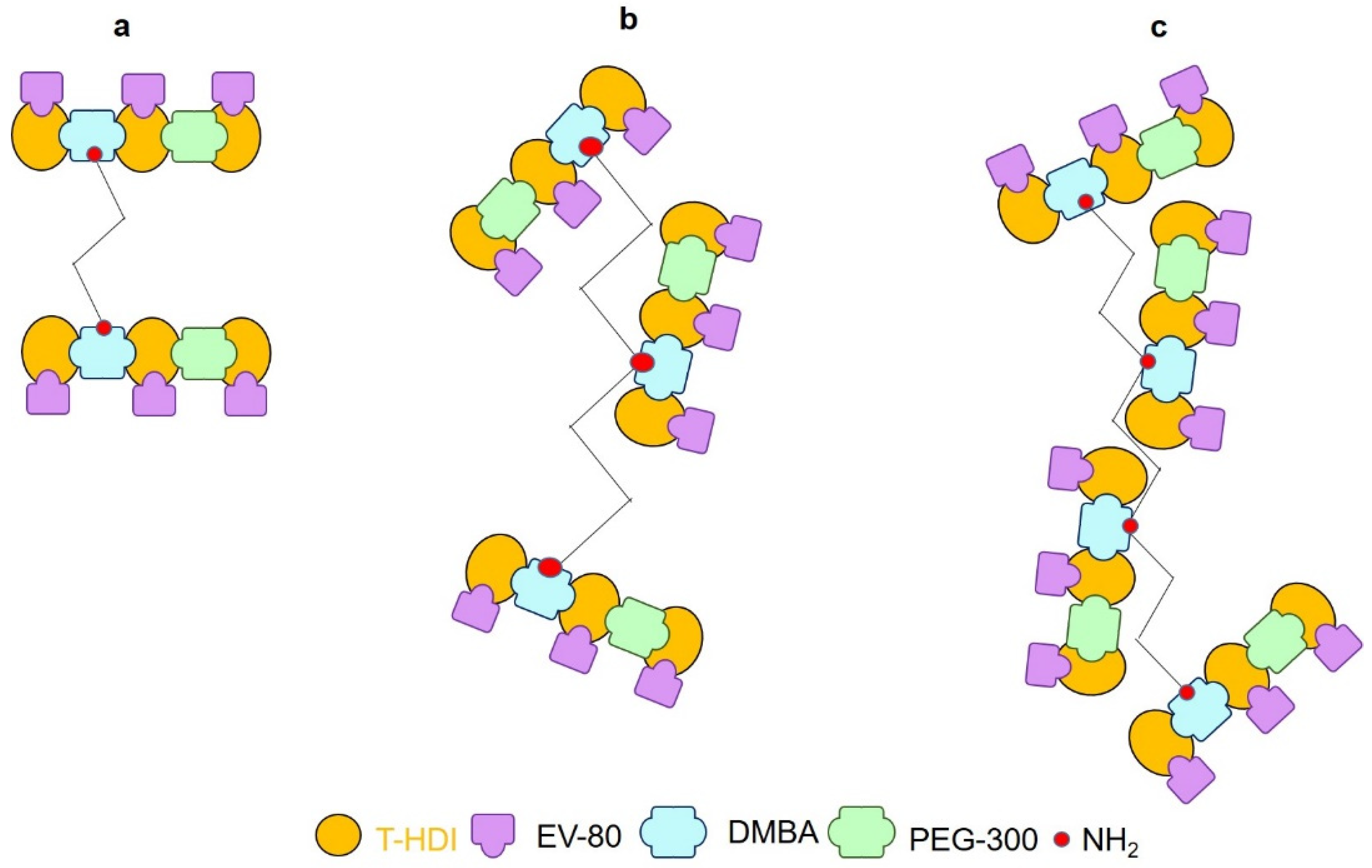
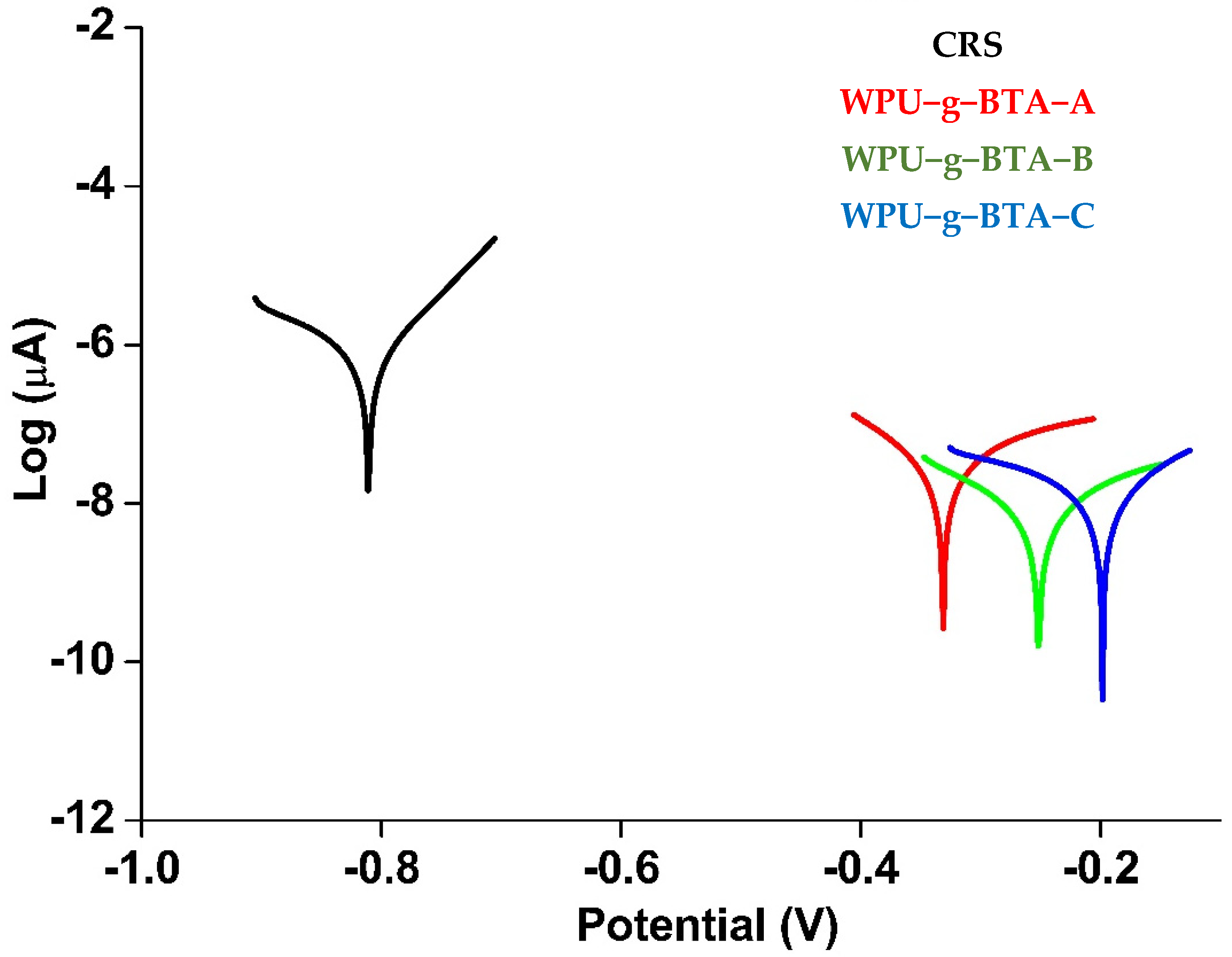
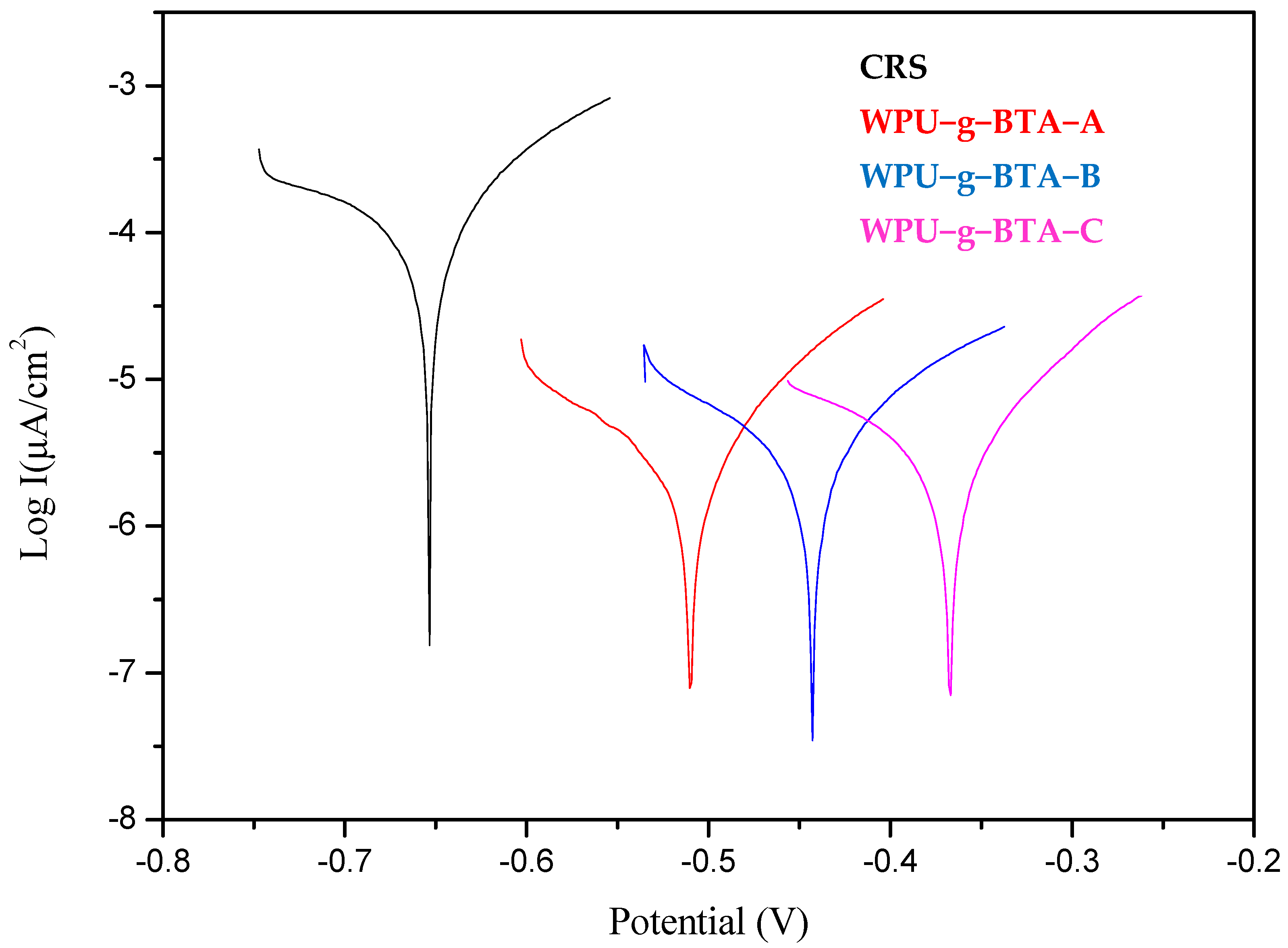
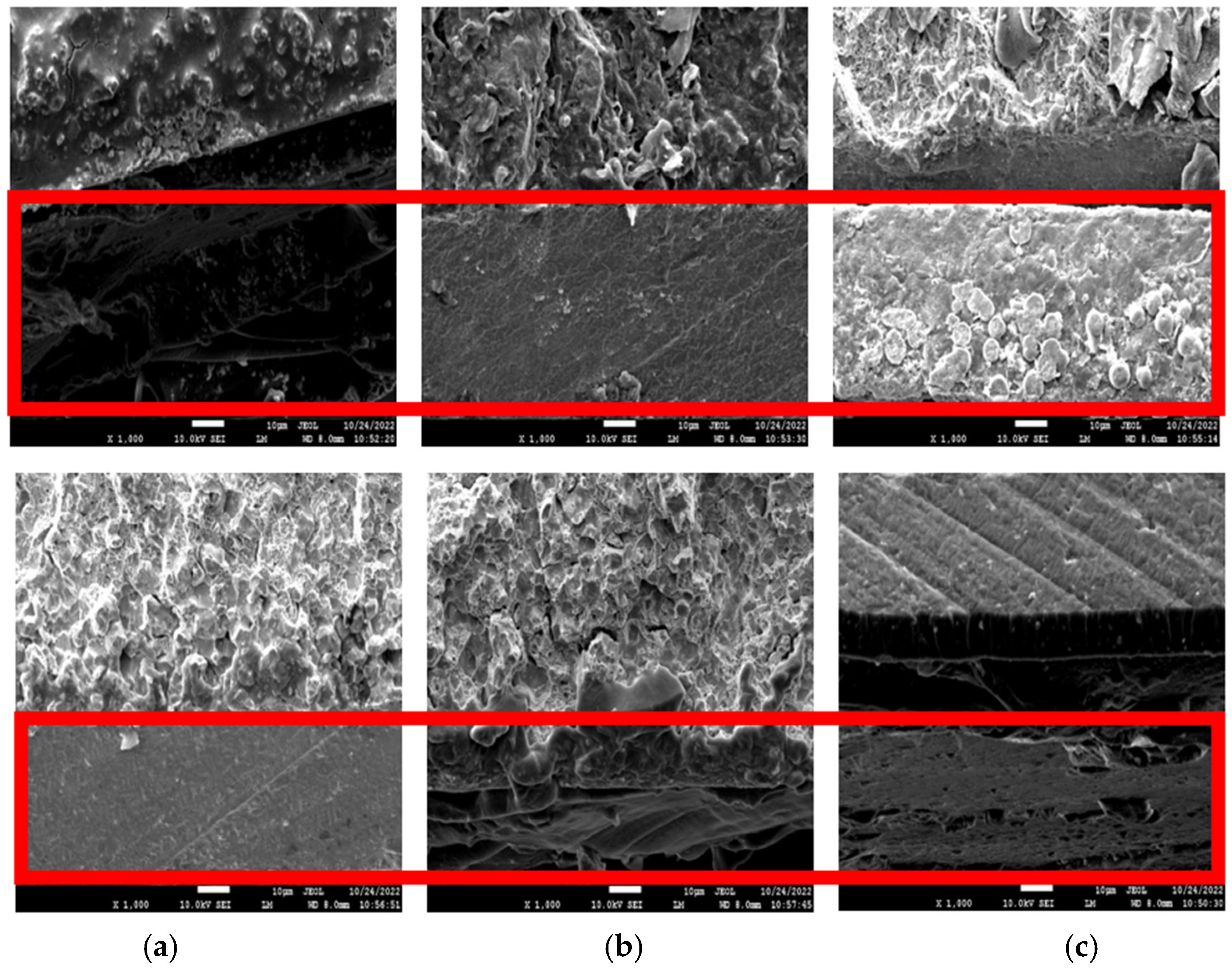
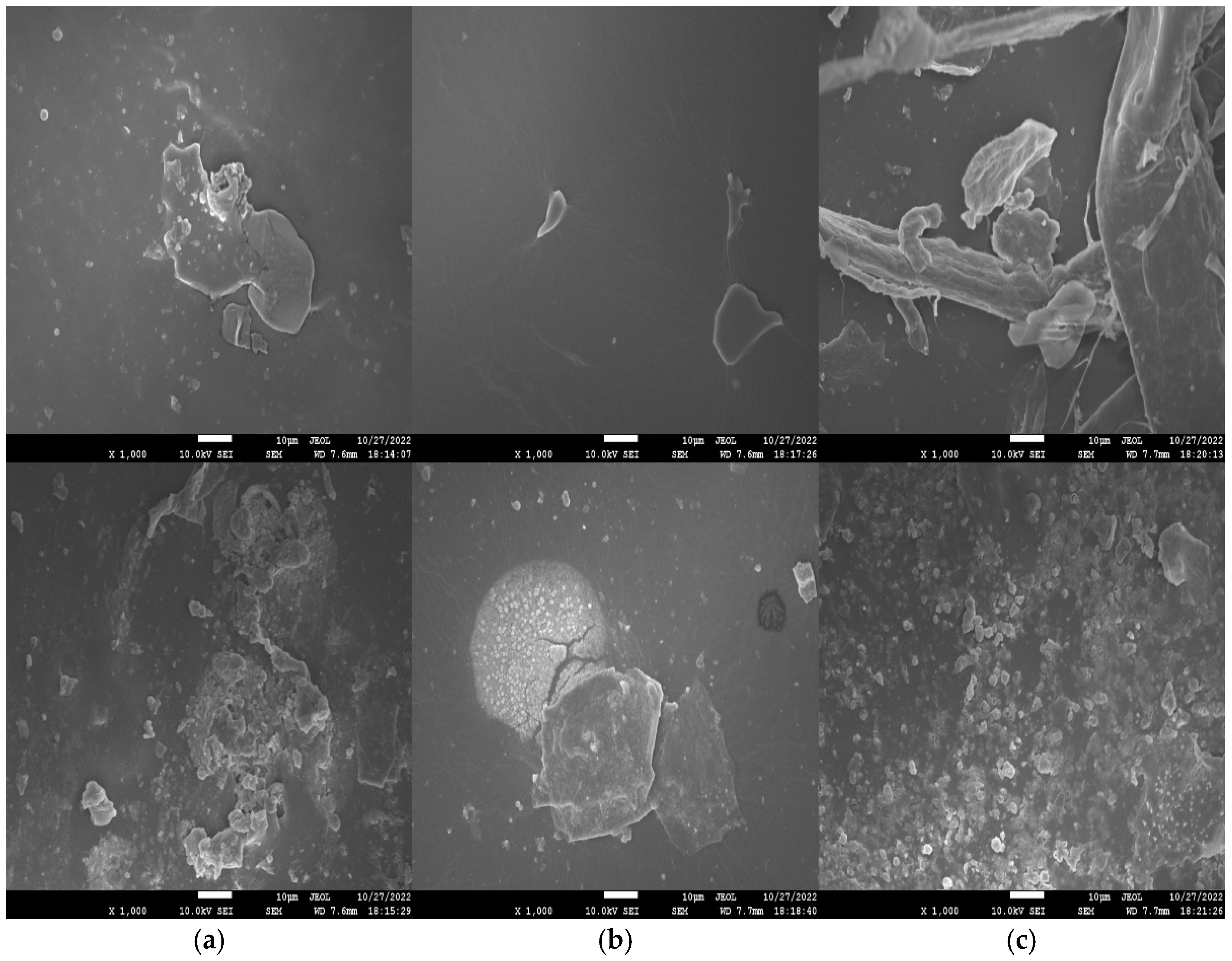
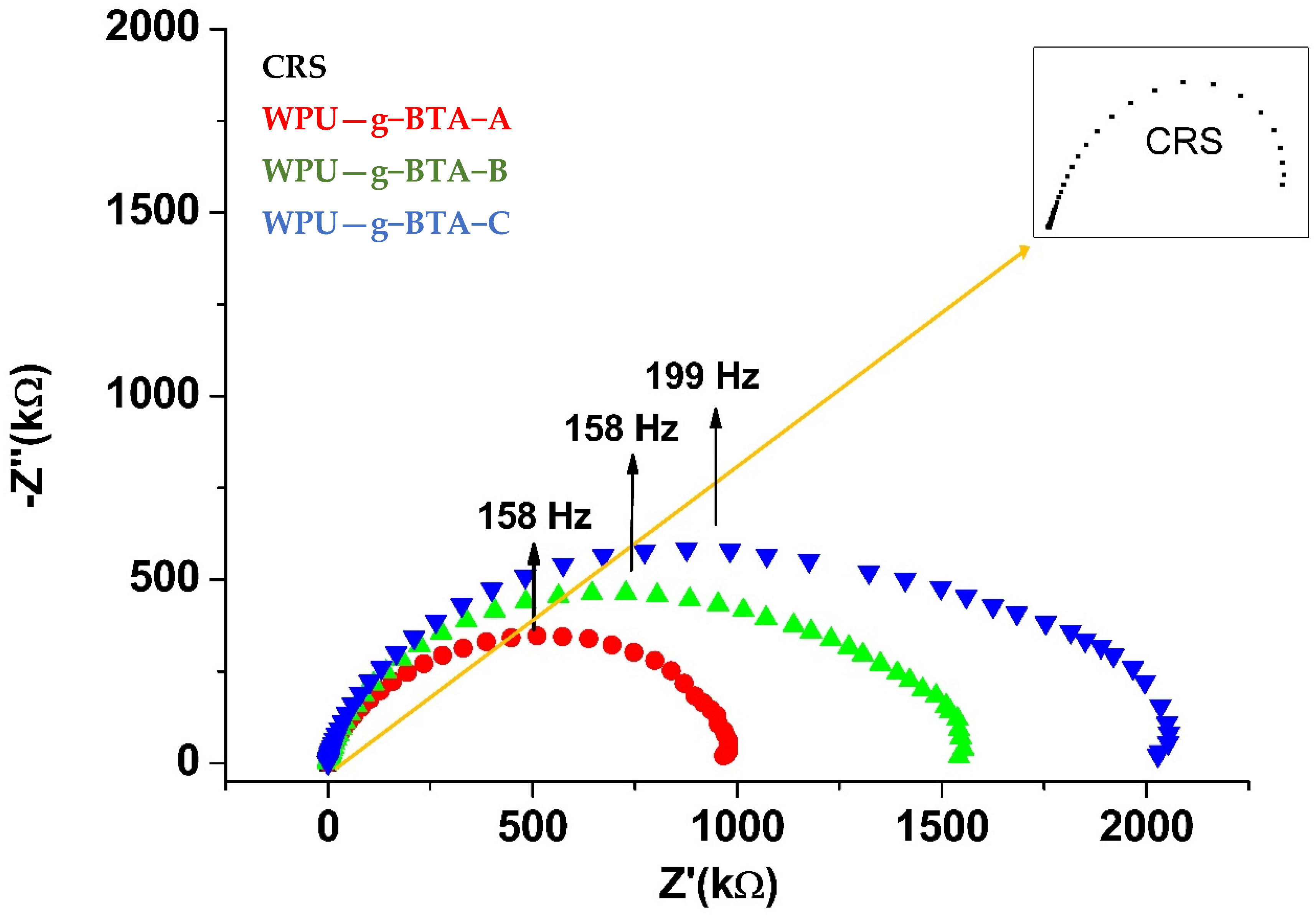
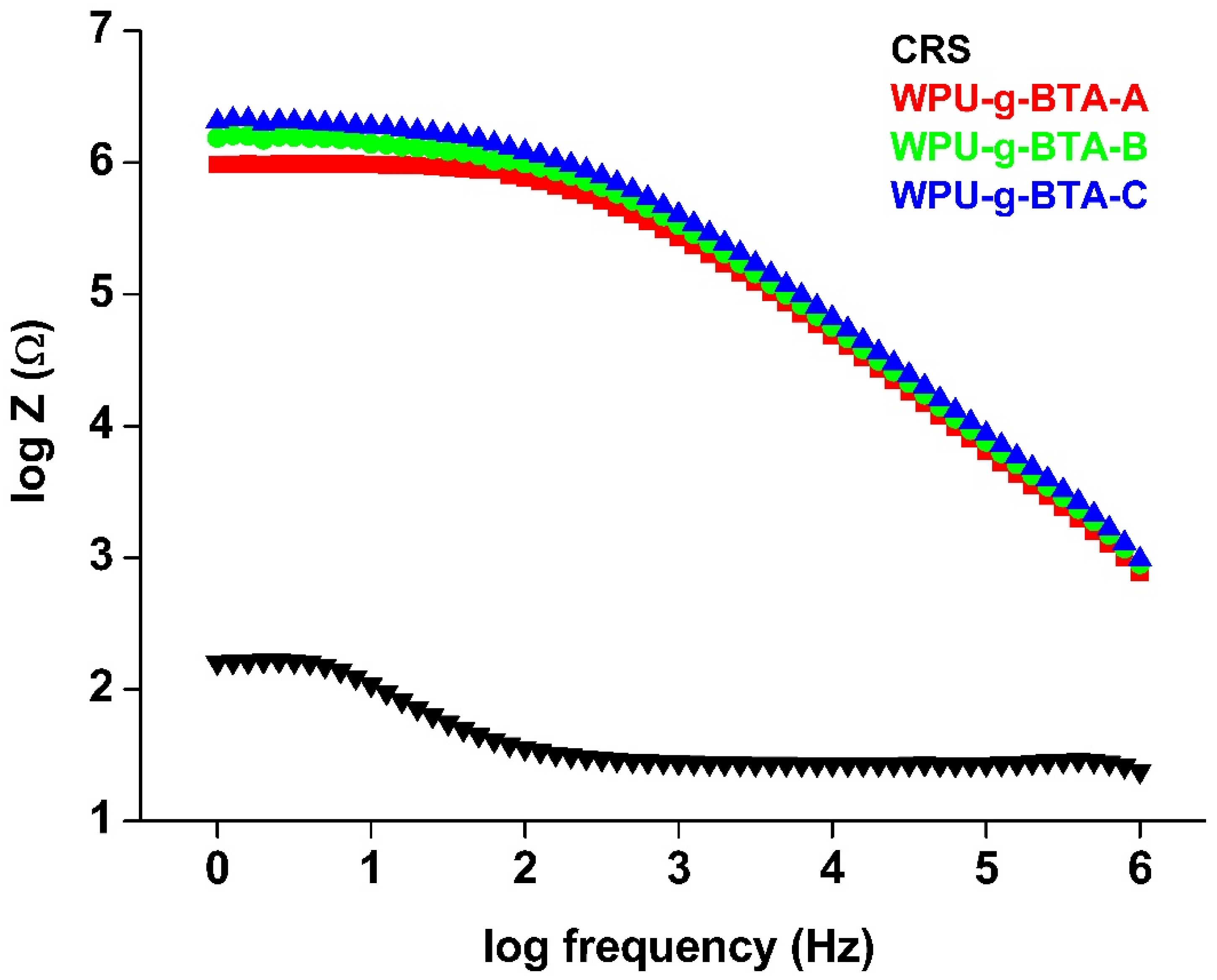
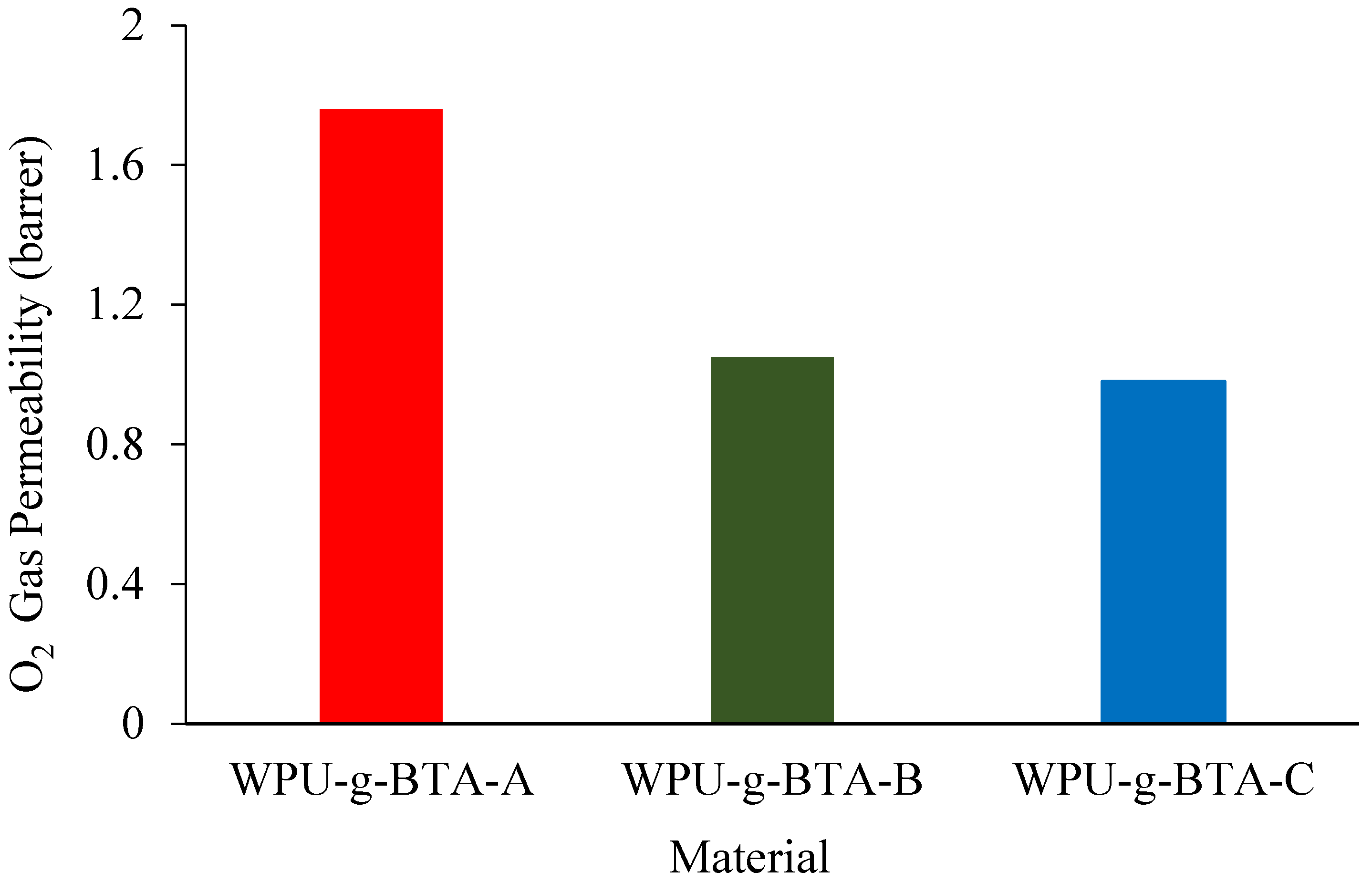
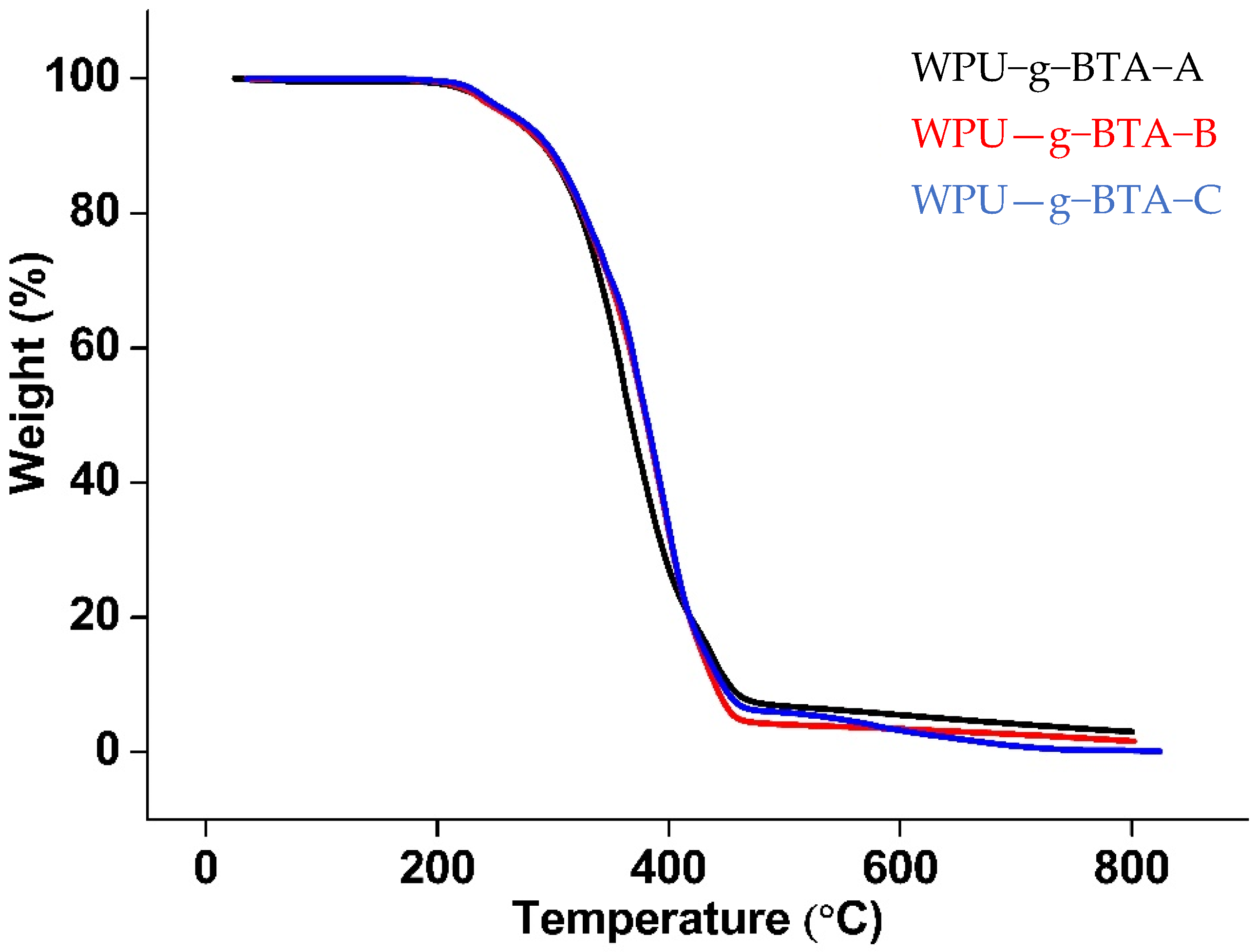
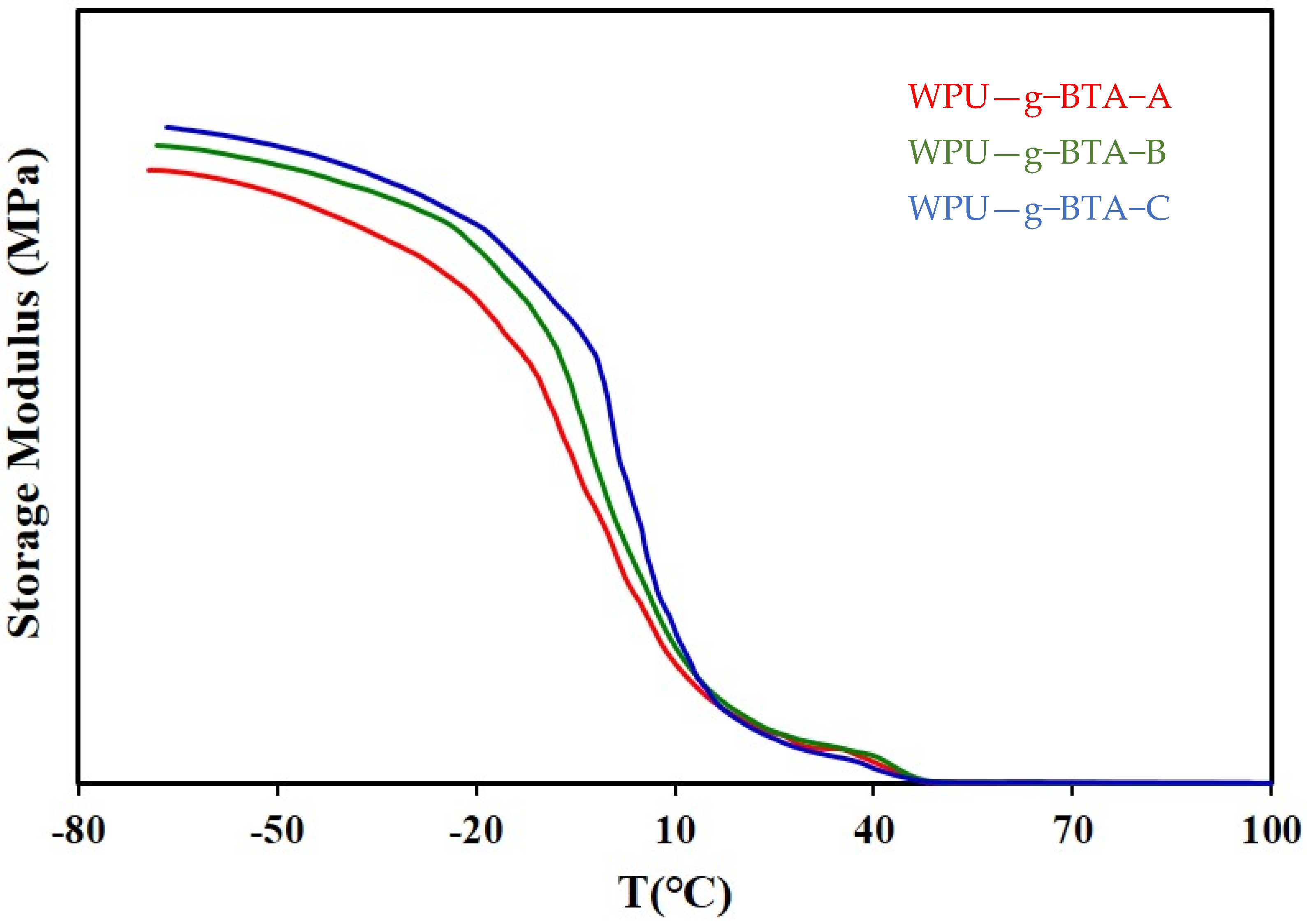

| Sample Code | WPU-g-BTA-A | WPU-g-BTA-B | WPU-g-BTA-C | |
|---|---|---|---|---|
| Gel content | Tube (g) | 13.7608 | 13.7386 | 13.7784 |
| Sample (g) | 0.6671 | 0.6675 | 0.6674 | |
| THF (g) | 20.171 | 20.0265 | 20.0255 | |
| After drying (g) | 13.8513 | 13.864 | 13.9231 | |
| Gel Content (%) | 13.57 | 18.79 | 21.68 | |
| Gas permeability | O2 (barrer) | 1.758322 | 1.045648 | 0.984704 |
| Thermal Stability | Td(5%) | 252.75 | 257.47 | 257.47 |
| Td(10%) | 288.26 | 292.41 | 295.69 | |
| Char yield % | 3 | 1.6 | 0.21 | |
| DMA | Stress (kgf/cm2) | 51.19 | 47.56 | 50.41 |
| Elongation (%) | 178.85 | 224.66 | 283.41 | |
| 100% modulus (kgf/cm2) | 42.15 | 44.12 | 46.51 | |
| Sample Code | CRS | WPU-g-BTA-A | WPU-g-BTA-B | WPU-g-BTA-C | |
|---|---|---|---|---|---|
| Coating thickness | (μm) | 60 ± 2 | 60 ± 2 | 60 ± 2 | 60 ± 2 |
| Electrochemical parameters | Ecorr (V) | −0.81121 | −0.3311 | −0.25208 | −0.19831 |
| icorr (μA/cm2) | 71.773 | 0.079 | 0.068 | 0.020 | |
| IE % | - | 99.889 | 99.905 | 99.972 | |
| EIS (Nyquist) | Z’ (kΩ) | 0.16 | 978.84 | 1552.69 | 2055.23 |
| -Z’’ (kΩ) | 0.09 | 346.95 | 462.90 | 582.83 | |
| BODE | log(Z) | 2.22 | 5.99 | 6.21 | 6.33 |
| Sample Code | Ecorr (V) | icorr (µA.cm−2) | Rp (kΩ) | PEF % |
|---|---|---|---|---|
| CRS | −0.634 | 4.98 | 2.587 | - |
| WPU-g-BTA-A | −0.633 | 4.17 | 3.065 | 16.16 |
| WPU-g-BTA-B | −0.576 | 4.08 | 2.349 | 18.13 |
| WPU-g-BTA-C | −0.550 | 3.41 | 3.127 | 31.56 |
Publisher’s Note: MDPI stays neutral with regard to jurisdictional claims in published maps and institutional affiliations. |
© 2022 by the authors. Licensee MDPI, Basel, Switzerland. This article is an open access article distributed under the terms and conditions of the Creative Commons Attribution (CC BY) license (https://creativecommons.org/licenses/by/4.0/).
Share and Cite
Bibi, A.; Tsai, E.; Lan, Y.-X.; Chang, K.-C.; Yeh, J.-M. Preparation and Characterization of Water-borne Polyurethane Based on Benzotriazole as Pendant Group with Different N-Alkylated Chain Extenders and Its Application in Anticorrosion. Molecules 2022, 27, 7581. https://doi.org/10.3390/molecules27217581
Bibi A, Tsai E, Lan Y-X, Chang K-C, Yeh J-M. Preparation and Characterization of Water-borne Polyurethane Based on Benzotriazole as Pendant Group with Different N-Alkylated Chain Extenders and Its Application in Anticorrosion. Molecules. 2022; 27(21):7581. https://doi.org/10.3390/molecules27217581
Chicago/Turabian StyleBibi, Aamna, Ethan Tsai, Yun-Xiang Lan, Kung-Chin Chang, and Jui-Ming Yeh. 2022. "Preparation and Characterization of Water-borne Polyurethane Based on Benzotriazole as Pendant Group with Different N-Alkylated Chain Extenders and Its Application in Anticorrosion" Molecules 27, no. 21: 7581. https://doi.org/10.3390/molecules27217581
APA StyleBibi, A., Tsai, E., Lan, Y.-X., Chang, K.-C., & Yeh, J.-M. (2022). Preparation and Characterization of Water-borne Polyurethane Based on Benzotriazole as Pendant Group with Different N-Alkylated Chain Extenders and Its Application in Anticorrosion. Molecules, 27(21), 7581. https://doi.org/10.3390/molecules27217581








